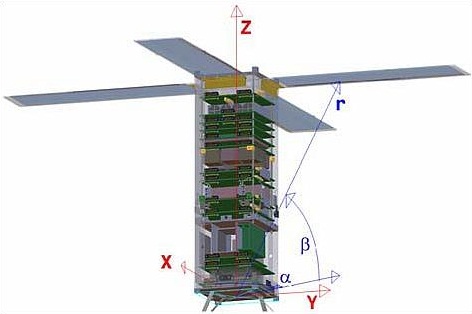Delfi-n3Xt

The 3U CubeSat Delfi-n3Xt is a 3-Kilogram spacecraft developed at the Technical University of Delft. The satellite uses four deployable solar arrays to provide 12W of power to its two payloads. A micro-propulsion system will be demonstrated as an in-orbit reconfigurable, high-efficient platform. The experimental micro propulsion system uses eight Cool Gas Generators to supply gaseous Nitrogen from a solid charge to build up a chamber pressure of about 4.5 bar. The small thruster is operated in blowdown mode providing a thrust of 6 to 100 Millinewtons. The Cool Gas Generators each are loaded with 0.3 grams of propellant that can be used to generate 0.1 liter of N2 gas.
Delfi-n3xt also carries a Multifunctional Particle Spectrometer which is a radiation detector that can measure the energy and incidence angle of alpha particles, protons, electrons and gamma radiation. The system is 7.5 by 7 by 8 centimeters in size, weighing 600g. It is capable of detecting gamma rays at energies of 0.2 to 3 MeV, electrons from 1 to 20 MeV, protons from 1-200MeV and ions from 6 to 400 MeV/n.
Testing a compact and power-efficient device in orbit could qualify the unit as a satellite health monitor that would be used on operational satellites to detect the cause of radiation-related problems of spacecraft electronics.
The satellite also carries a Solar Cell Degradation Measurement payload that will expose new types of solar cells to the space environment and measures the performance of the cells over time to assess their degradation. Additionally, the satellite carries a Space Flash system that uses commercial SD memory cards and additional electronics that make the storage medium immune to radiation over a two-year period. The performance of that system will be evaluated throughout the mission.
Low data rate VHF and UHF communications are used for telemetry downlink and command uplink while S-Band is used for data downlink.
